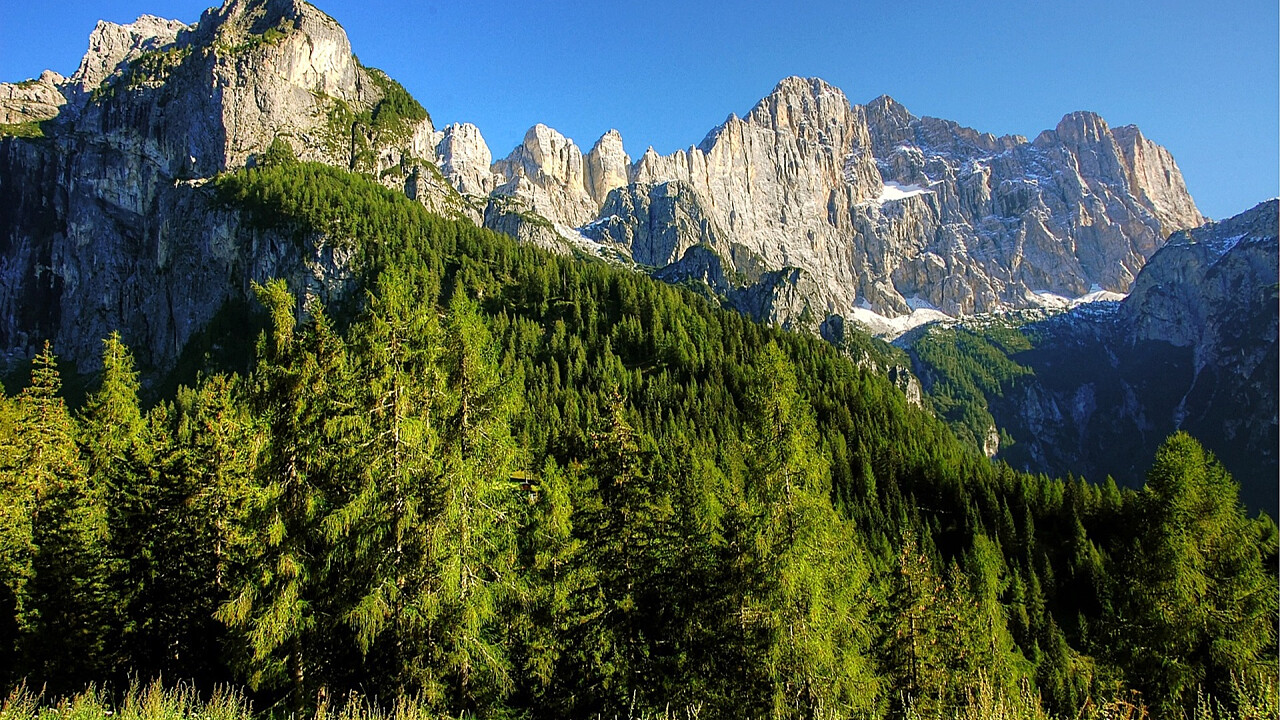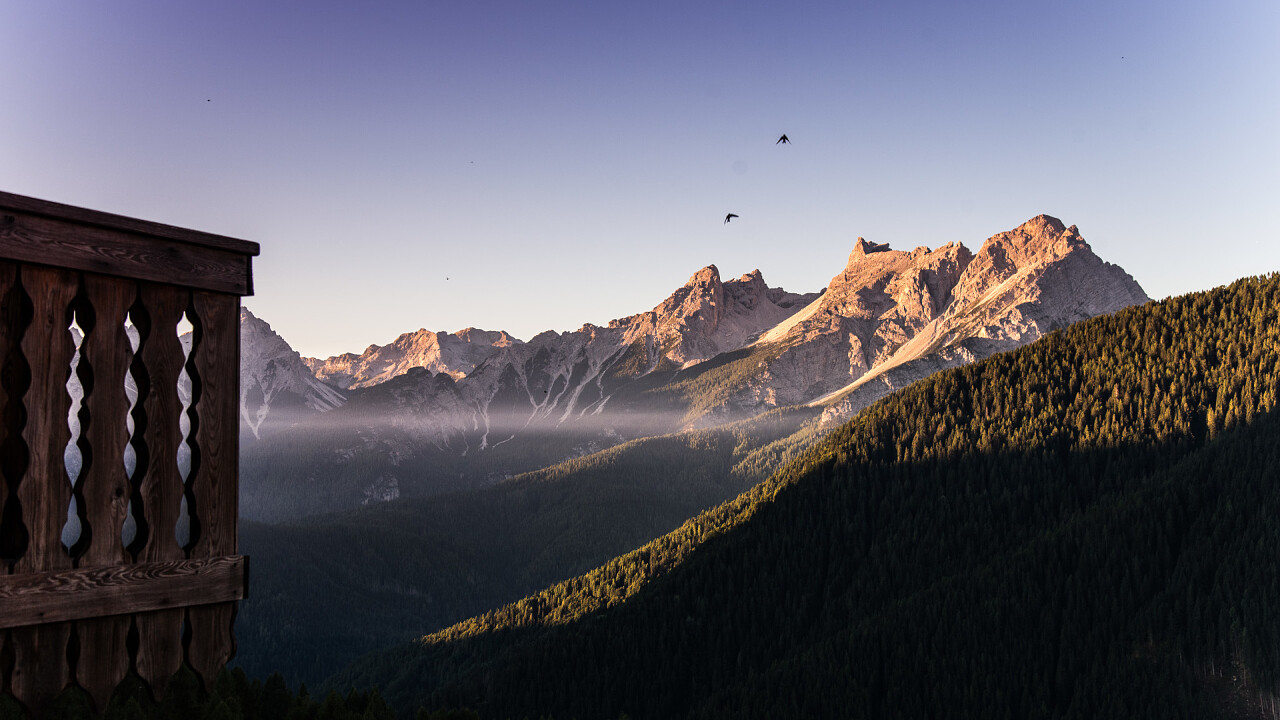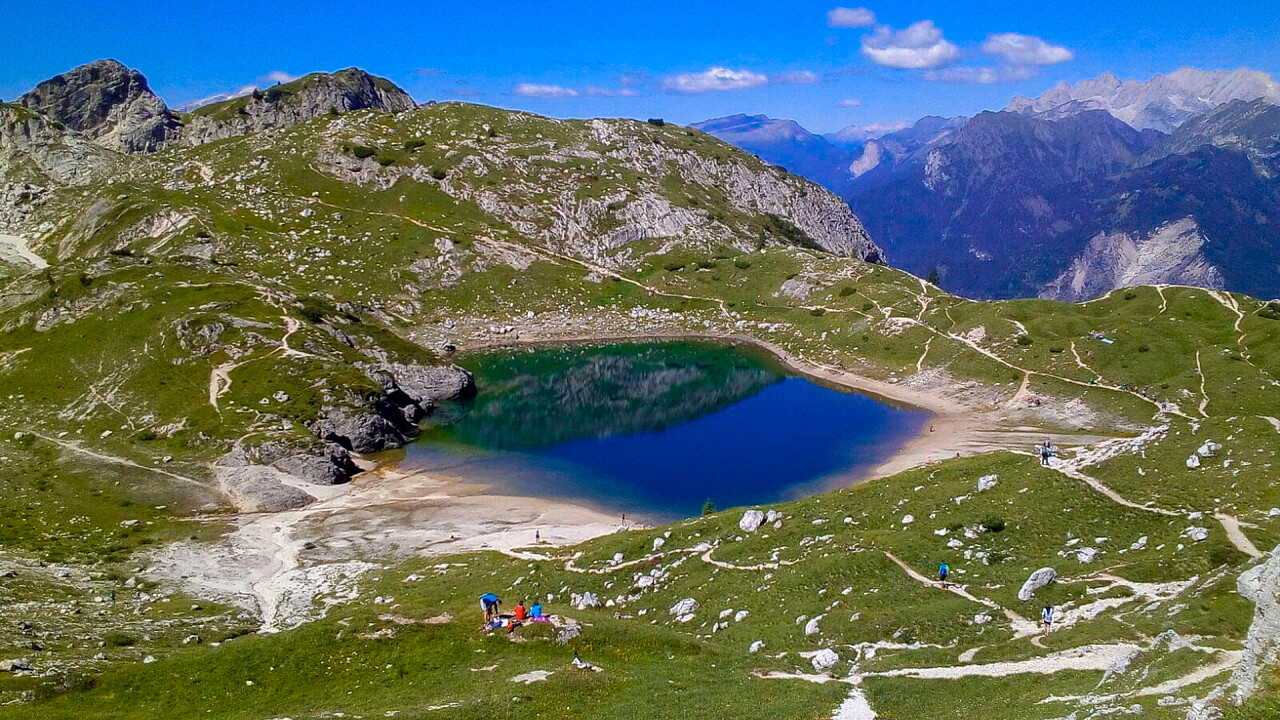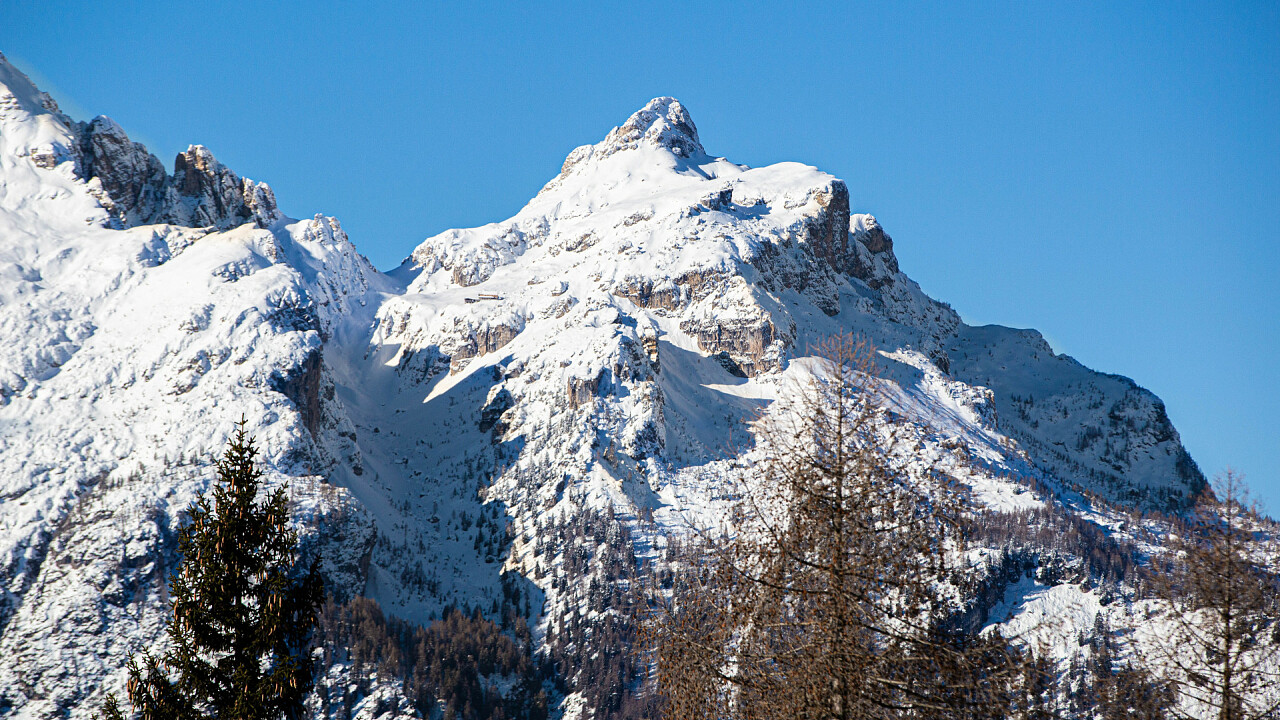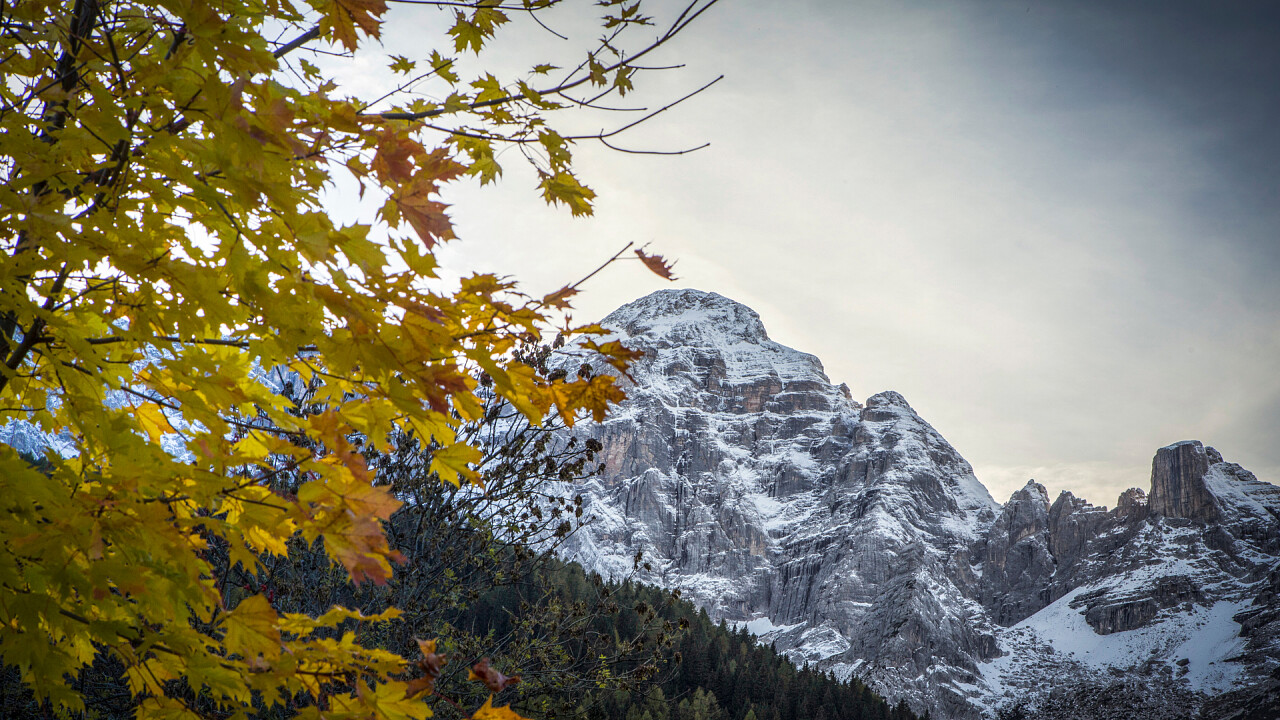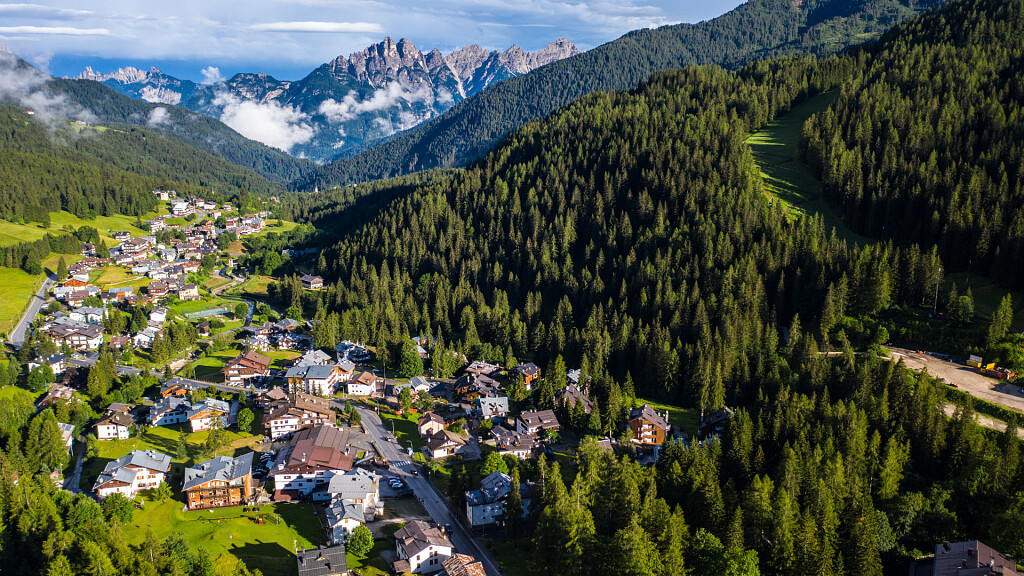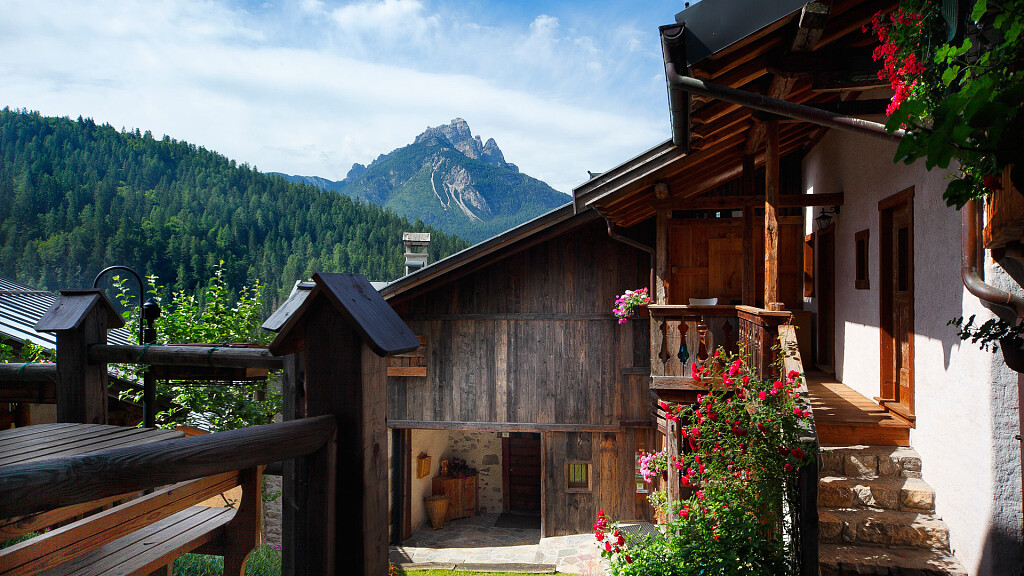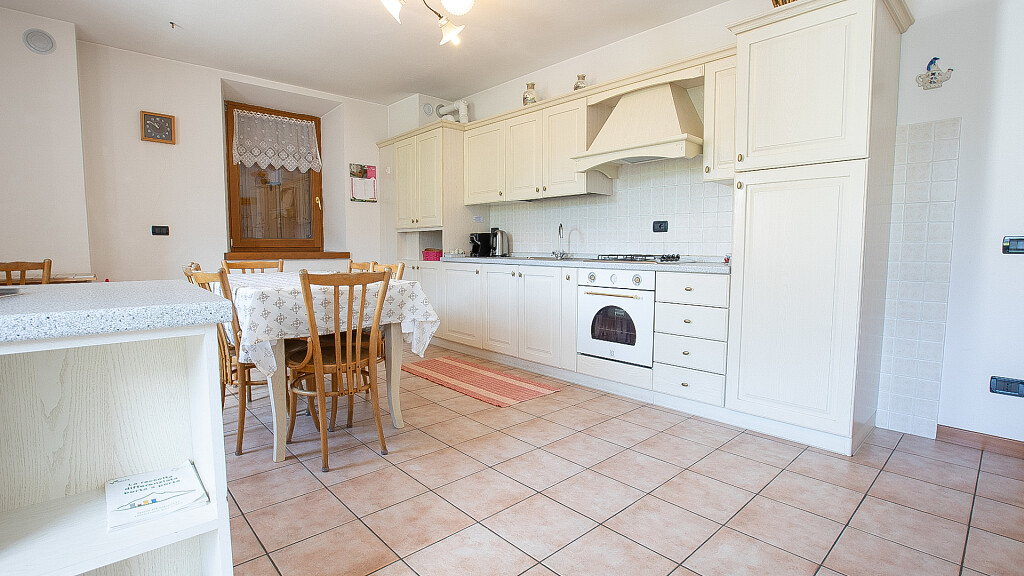The most beautiful rock wall in the Alps
Dino Buzzati's book “I fuorilegge della montagna – Uomini, cime, imprese”
The Civetta Group (El Zuita in Veneto Ladin language), located in the province of Belluno, rises majestically between Zoldo Valley and Agordino, reaching with its main peak at 3220 m a.s.l.
The imposing north face, between the “Cima Su Alto” and the “Torre Coldai”, known by climbers as "the Kingdom of the sixth degree" or "Wall of the Walls", looks at the village of Alleghe, while to the south the mountain form the Moiazza group. At the foot of Mount Civetta there is Lake Coldai.
Civetta, declared a World Heritage Site in 2009, is a place known and frequented by all mountain enthusiasts, who in every season of the year can practice various activities, immersed in the beauty of the Dolomites.
In summer, it is a popular destination for climbers and hikers, who can count on several paths and refuges where to stop, and by runners for the famous Transcivetta.
In winter, Mount Civetta accompanies skiers along the slopes of Ski Civetta.
In summer on Mount Civetta
It is the pleasant walks from refuge to refuge, mountain biking, e-bike and fat biking and climbing that dominate the summer season on the Civetta. Trekking loverss have at their disposal a dense network of hiking routes, distributed throughout the territory.
Very characteristic, but difficult is the route of Civetta Valley starting from Alleghe: you take the lifts to “Col dei Baldi” and then follow the path that leads to “Malga Piòda”. At Rifugio Coldai and at the lake continue between ascents and descents accompanied by the big North-West Face up to Rifugio Tissi. From here you go up to “Col Rean” where you can admire in all their grandeur the peaks “De Gasperi”, “Su Alto” and “Terranova”. Then, continue towards the “Aghi of Pelsa” to Rifugio Vazzoler and from here to Capanna Trieste.
Another beautiful itinerary is from Capanna Trieste through the Rifugio Vazzoler that leads to Rifugio Tissi and back, to be done especially in the autumn to admire the show of fall foliage.
Mount Civetta is part of the “Alta Via” n.1 and the Monaco-Venice walk. On its slopes there is also the fascinating Zoldano Ring. The presence of the lifts also allows families and the little trained to walk at the foot of the Civetta, reaching for example the picturesque Lake Coldai.
Mountaineering and via ferrata on Mount Civetta
Mount Civetta is frequented and much loved by climbers and mountaineers from all over the world where there is a series of routes and vie ferrate of different degrees of difficulty.
The first to officially reach the summit in 1867 was the Englishman Francis Fox Tuckett with the Swiss guides Jacob and Melchior Anderegg, although probably the first ever was Simeon De Silvestro, hunter of Pecol in 1855.
The most famous routes, such as the Solleder-Lettembauer and the Andrich, develop along the legendary "wall of the walls" (1000 m of altitude difference for about 4 km in length), on the north-west side of the mountain range. Here, climbers from all over the world have always challenged each other, thus confirming the importance of the Civetta Group in the ranking of the most popular vertical walls.
Alongside the more demanding routes there are many others that can be undertaken to reach the different peaks “Monte Civetta", "Punta Tissi" and "Punta Civetta” all however difficult.
However, there are three access routes to this colossus of the Dolomites: the normal route starts from Rifugio Sonino Al Coldai on the east side, while two are the via ferrata: the “Ferrata degli Alleghesi”, starting from Rifugio Sonino Al Coldai that allows you to reach the summit through “Punta Civetta” and “Punta Tissi”; and the Ferrata Tissi starting from Malga Grava to Rifugio Torrani, along the south-west side of “Civetta Bassa”.
The refuges on the Civetta: Torrani, Coldai, Vazzoler and Tissi
Are the 4 shelters around the Civetta Group.
Rifugio Maria Vittoria Torrani located in Zoldo Valley 200 meters from the summit, on the “Pian della Tenda” at an altitude of 2984 m a.s.l.. Inaugurated in 1938, it can be reached by taking the normal route of Mount Civetta or starting from Pecol or “Casera della Frava” through the Passo del Tenente. From Rifugio Sonino Al Codai can be reached through the Via ferrata degli Alleghesi deviating just before the summit or from the Passo del Tenente. For the more trained, you can reach it from Val delle Sasse starting from Capanna Trieste along the Via ferrata Attilio Tissi.
The Rifugio Sonino Al Coldai is located in Ziolere Valley in the Zoldo Valley at an altitude of 2132 m s.l.m. and can be reached from Palafavera following the hiking trails 564 and 556 or from Alleghe.
The Rifugio Mario Vazzoler is located at the foot of the Civetta Group in Corpassa Valley in Taibon Agordino at 1714 m a.s.l. and can be reached from the Rifugio Capanna Trieste. This can also be accessed by car, along the 555 dirt path. It is located in an excellent position right at the entrance of the Cantoni Valley, a beautiful valley surrounded by spires and pinnacles on which numerous ways have been opened, including the “Torre Venezia”, the “Torre Trieste” - the most famous - the “Campanile Pian di Lora”, “Cima dell'Elefante”, “Punta Agordo”, etc.
The Rifugio Attilio Tissi is located on the Reàn Hill in Alleghe, in the grips of the great north-west wall, at 2250 m of altitude. The refuge can be reached from Rifugio Sonino Al Coldai via “Forcella Col Negro” or from Rifugio Vazzoler.
The Transcivetta: mountain run on the Civetta Group
The Transcivetta has become over the years an appointment increasingly awaited by all fans of mountain racing in pairs both competitive and non-competitive. A challenging route of 23 km starting from Listolade/Taibon Agordino and arriving at “Piani di Pezzè” in Alleghe, touching the refuges Capanna Trieste, Vazzoler, Tissi and Coldai which usually takes place every year in July.
Discover the Transcivetta event [link pagina Transcivetta ENG – vedi prossima e-mail]
Winter time on the Mount Civetta
In winter the famous Ski Civetta Area [ link > https://www.dolomiti.it/en/skiarea/civetta ], the largest in Veneto Region, which includes the vast area between Alleghe, Zoldo Valley, Selva di Cadore and Palafavera, offers more than 80 kilometers of ski slopes, connected by modern lifts and 4 ski buses. There are also circuits for cross-country skiing, snowpark, itineraries for snowshoeing, ice stadiums, events and fascinating excursions for those who practice ski mountaineering.
The Civetta area is part of the Great War ski tour [ link > https://www.dolomiti.it/en/itineraries/alpine-skiing/skitour-of-the-first-world-war].
Mount Civetta: origin of the name
The Civetta appears for the first time in a document dating from 1665 as “Zuita”, while it appears in the official map in 1774. There are two hypotheses about the origin of the name: the first claims that it comes from the Latin civitas, because the slope that gives on the city of Alleghe resembles a city surrounded by towers; the second hypothesis holds that since also in the Zoldo Valley the mountain is called Civetta, the name derives from the nocturnal raptor (Civetta means Owl in Italian), maybe because it once looked at the mountain with suspicion and fear, as if it were a carrier of misfortune.
Legend of Lake Coldai on Mount Civetta
A legend tells that near Lake Coldai lived a dragon with big wings, black tongue and fiery red eyes. He did not fly often, he loved to stay in his lair, but when he did he flew to Lake Fedaia. When the inhabitants saw him they already knew that natural disasters or very hard times would come. It is said that he was last seen flying just before the landslide of Mount Piz that went to form the Lake of Alleghe.
How to get on the Civetta
By car
Take the A27 motorway to Pian di Vedoia (Belluno). From here follow the signs for Longarone-Val di Zoldo or for Agordo-Cencenighe-Alleghe.
By plane
The nearest international airport is Treviso, from where you have to reach by bus the train station of Treviso and continue to Belluno.
By train
The nearest railway stations are in Longarone and Belluno, from where the Dolomitibus buses leave for Alleghe/Caprile and Longarone/Pecol.
By bus
Once in Belluno, you move to the train station and right in front of you is the bus station of the Dolomitibus, from where buses depart to the various towns of the Civetta Area.

